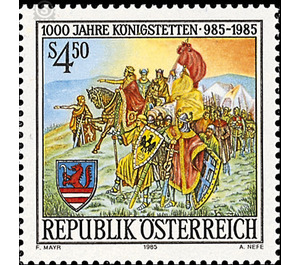1000 years - Austria / II. Republic of Austria 1985 - 4.50 Shilling
Theme: Animals
| Country | Austria / II. Republic of Austria |
| Issue Date | 1985 |
| Face Value | 4.50 |
| Color | multi-colored |
| Printing Type | combination printing |
| Stamp Type | Commemorative |
| Item Type | Stamp |
| Chronological Issue Number | 1168 |
| Chronological Chapter | OOS-OE2 |
| SID | 174680 |
| In 68 Wishlists | |
The name of the market town Königstetten, in Tullnerfeld, is derived from "Chunihohesstetin". Chunihohe is an old German male nickname. This spelling can be found in a document Pilgrims of Passau (971-991n.Chr.). The period of origin of the certificate is 973-985. This document thus gave rise to the 1000th anniversary of 1985. At the time of its first nomination, Königstetten was in close contact with Bavaria and the Church of Passau. The coat of arms of the place points out. It is preserved in an imprint of the market seal from 1571. He shows the three times divided shield and the growing right from the shield division right wolf, the heraldic animal of the Passau bishops. In 1438 Königstetten was raised to the market. In the year of the Turkish siege of Vienna in 1683 Königstetten was badly affected. The reign of Joseph II was the most significant event of the 18th century for the economic and political future of the place. As an old wine-growing region, very early on various monasteries planted vineyards. Many monasteries now sold their wineries to forestall possible "nationalization." Through the church policy of the emperor, the Hauer owners of the monastery vineyards. The brand motif shows the legendary foundation of Königstetten after a painting by August Stephan (c. 1870).


